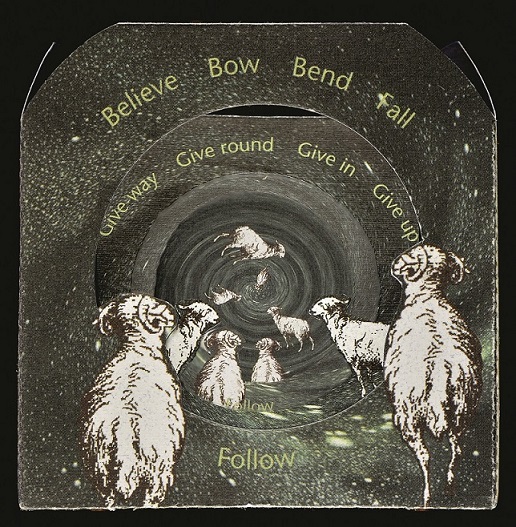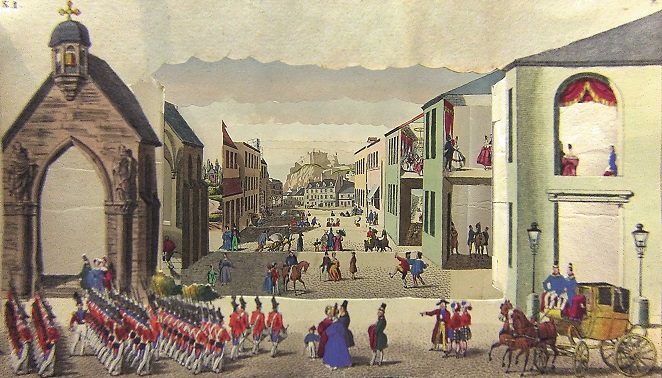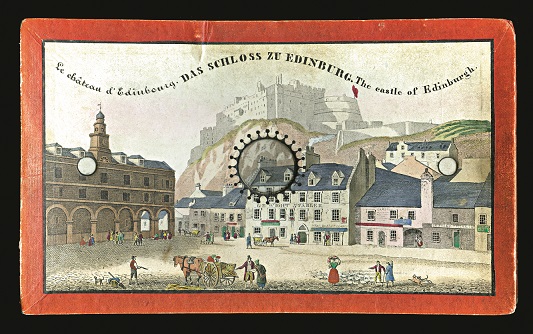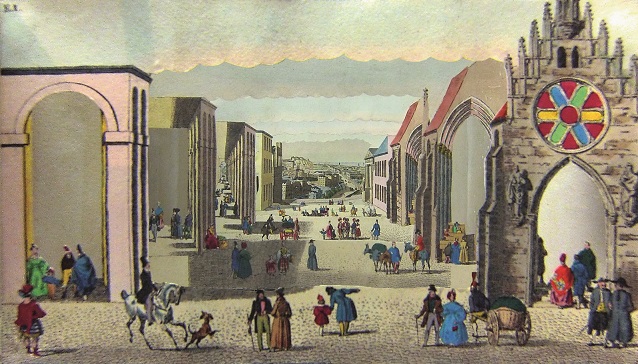We are all familiar with a paper peepshow’s basic structure: a front-face with one or more peep-holes, followed by a series of cut-out panels, all connected by bellows on two sides. Yet, in nineteenth-century Germany, many publishers were not content with merely going along with this format. During my research in the Gestetner Collection at the National Art Library, I was constantly surprised by German publishers’ imagination that gave birth to a wide range of non-conventional paper peepshow formats. These innovative structures sought to offer the user different viewing experiences. In this blog, I would like to introduce some of these works.
Through the Looking Glass
The first work, called ‘Berlin‘ (Gestetner 75, ca. 1828), is the earliest German paper peepshow in the Gestetner Collection. It depicts the boulevard Unter den Linden in the German capital. The front-face is not a piece of card but a viewing mechanism consisting of two card boards, a frame, and a mirror. When we lift the part of the front-face with the Brandenburg Gate print, another card section folds out. This leaf has a tongue in the centre, which can be inserted into the opening in the frame surrounding the front-face (see image below).
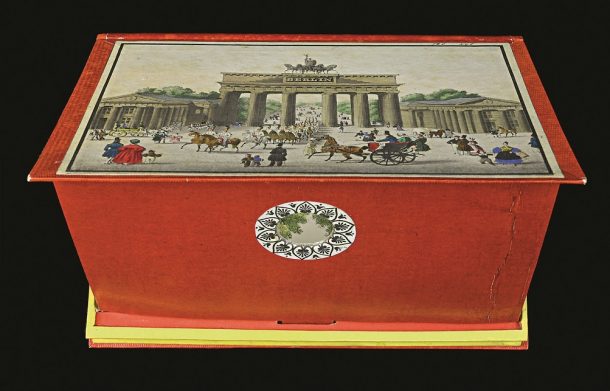
Once in this position, we have a three-dimensional triangle standing on top of the cut-out panels. We then need to lift this triangular structure to allow the bellows to open up. At this point, we can look through the peep-hole and be surprised to find out that the peep-view is reflected in the mirror hidden on the reverse of the front panel.
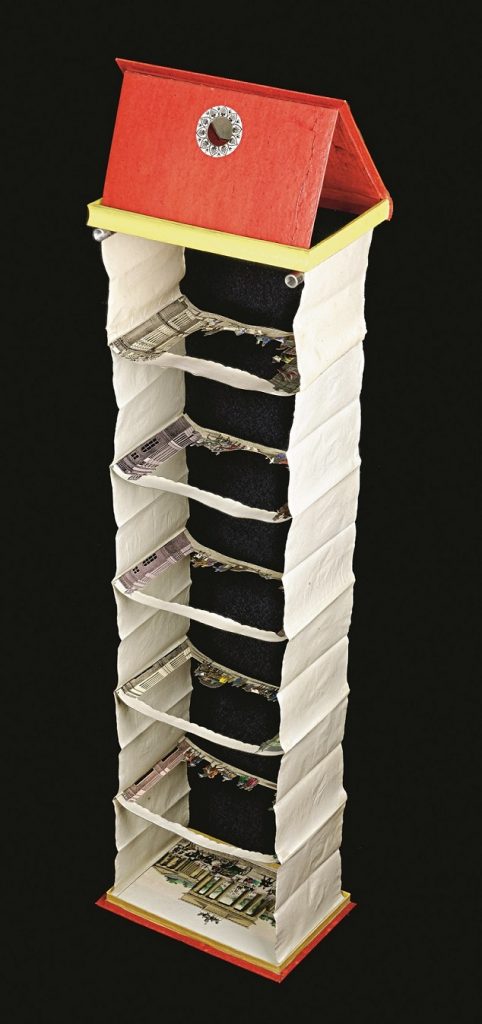
Compared to the experience of looking into a conventional paper peepshow, handling ‘Berlin‘ is much more interactive, and a person unfamiliar with this structure might also encounter pleasant surprises while trying to figure out how the mechanism works. Unfortunately for the publisher, although the innovative structure is undoubtedly a plus for the competitive market, they seemed to forget that a mirror reflection is a reversed image. As they did not swap the sides of the street in the panels, all the monuments and iconic architecture end up on the wrong side of the street in the peep-view!
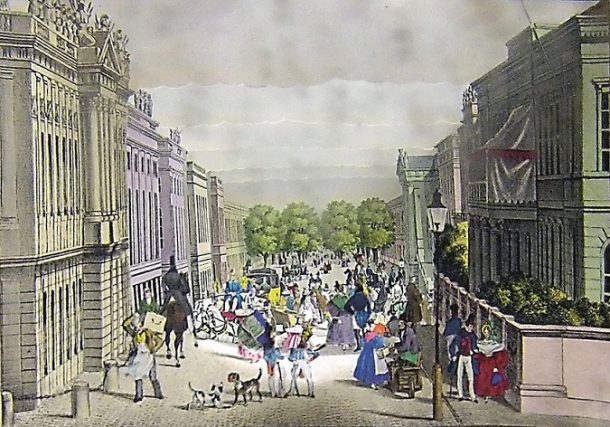
A double-sided paper peepshow
‘Edinburg/Das Schloss zu Edinburg‘ (Gestetner 106, ca. 1835), though less complicated, is another example adopting an unconventional structure. This work is a double-sided paper peepshow: it has two front-faces, one on each end of the paper peepshow and each with a peep-hole; this structure therefore requires each cut-out panel to be printed on both sides. There is no back-scene printed on the last panel. Instead, a removable backdrop, which also has one image on each side, can be inserted at either end, depending on how the peepshow is being viewed. This work thus offers two peep-views: one shows Edinburgh Old Town and the other the New Town.
A small moving panorama
Other publishers came up with different systems to allow for more than one peep-view. ‘[Miscellaneous Scenery]’ (Gestetner 158, ca. 1843-5) is a work that takes inspiration from the moving panorama. Instead of using a print as the back-scene, the producer embedded in the paper peepshow a paper scroll that consists of seven different prints, each showing a famous sight in Germany or Britain. The scroll is attached to two wooden winders that protrude to the front of the frame that surrounds the paper peepshow (see below). On turning the winders, one can witness various landscapes unfold through the peep-hole. This paper peepshow would have been impossible to enjoy on one’s own: while one person held the front face and looked through the peep-hole, another was needed to turn the winders. for the scroll to turn smoothly. A fun pastime for friends or family gatherings!
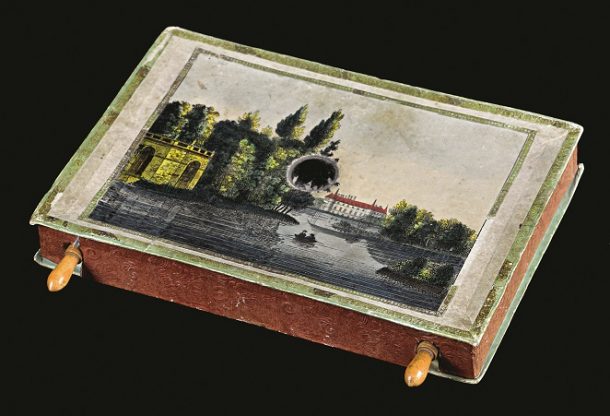
It is hardly surprising that among countries producing paper peepshows in the nineteenth century, Germany would be the one that is characterised by the greatest diversity of formats. After all, in the 1800s, the German city Nuremberg was one of the most important print centres of Europe, and the production of and trade in toys had a long tradition in this city too. As a printed ephemera, the paper peepshow must have been often bought as a toy, which could be played with by both children and adults. In his 2015 catalogue Paper Peepshows: The Jacqueline & Jonathan Gestetner Collection, Ralph Hyde lists all the German publishers whose name appears on nineteenth-century paper peepshows: all but one were based in Nuremberg, running a business either as printer/publisher or as toymaker. For producers in Nuremberg, developing new wares was a matter of survival in a very competitive environment, and they had to constantly bring novelty onto the market. Their works would then go on to influence publishers in other parts of Germany.
The German production shows that, although the paper peepshow structure is rather simple, it offers many opportunities for changes and innovation, bringing the user different viewing experiences. Experimenting with the paper peepshow format did not stop with the nineteenth century. Today, many artists are also inspired by the concertina, layered panels of the paper peepshow, and explore this structure in their practice. In fact, artists regularly get in touch with us to come and examine historic paper peepshows from the collection, so that they can gain a greater understanding of how they work and then create their own version.
